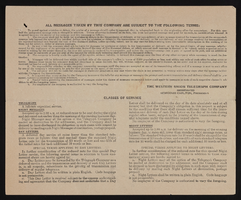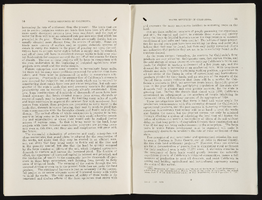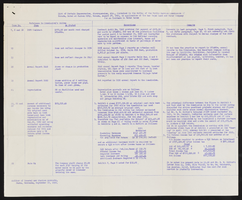Search the Special Collections and Archives Portal
Search Results

Meeting minutes for Consolidated Student Senate, University of Nevada, Las Vegas, September 01, 1981
Date
1981-09-01
Archival Collection
Description
Includes meeting agenda and minutes along with additional information about the memorandum and aquarian earth fair. CSUN Session 11 Meeting Minutes and Agendas.
Text

Meeting minutes for Consolidated Student Senate, University of Nevada, Las Vegas, June 01, 1982
Date
1982-06-01
Archival Collection
Description
Includes meeting agenda and minutes. CSUN Session 12 Meeting Minutes and Agendas.
Text
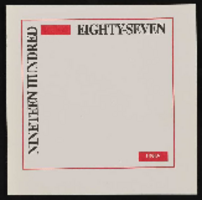
University of Nevada, Las Vegas (UNLV) 24th commencement program
Date
1987-05-17
Archival Collection
Description
Commencement program from University of Nevada, Las Vegas Commencement Programs and Graduation Lists (UA-00115).
Text
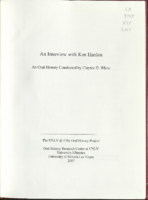
Transcript of interview with Ken Hanlon by Claytee D. White, November 29, 2006
Date
2006-11-29
Archival Collection
Description
Ken Hanlon was born in Baltimore, Maryland, in 1941. He attended 2nd grade through high school in Parkville schools. He took up his first instrument, the snare drum, at the age often, and by eighth grade had taken up baritone horn and trombone. His parents were very supportive of his interests. Ken developed a very strong work ethic early on, through the influence and example of his parents. He earned money in high school to pay for things he wanted by assisting on a paper route. He also took private lessons, which he paid for, and played in a dance band. After graduation, he attended Peabody Conservatory on a scholarship. He finished his last two years there with the principal of the Baltimore Symphony. He taught at Peabody Preparatory for seven years as undergraduate and graduate. He continued his Master's degree at Peabody Conservatory while working as a public school instrumental music teacher. He also played in the rock and roll band and worked in a city concert band. In 1968, Ken and his family moved to Las Vegas. He connected with the Si Zentner band and went on the road with him, then played in hotels up and down the Strip. Ken worked in bands that backed many famous headliners and has many anecdotes and memorable stories to share about those days. In 1970, Ken interviewed with Howard Chase, chair of the music department at UNLV. He was hired and his first UNLV job at the age of 29 was chair of the music department. He kept this position for 16 years, with one year off to establish residency for his doctorate. Dr. Hanlon has had a long and varied career, filled with people, places and events vital to the music industry. Today he continues to teach a graduate course, is currently Las Vegas president of the International Trombone Association, and runs the Arnold Shaw Popular Music Research Center.
Text

Biographical essay by Eva Peters, 2014
Date
2014
Archival Collection
Description
Peters' essay describes her family's journey to escape the Nazis and Communism, remaining in Hungary until 1956. She and her husband were part of the Hungarian Freedom Fighters group, and escaped to Vienna, and then to the U.S.
Text
Audio recording clip of interview with Faye Todd by Claytee D. White, October 15, 1996
Date
1996-10-15
Archival Collection
Description
Part of an interview with Faye Todd by Claytee White on October 15, 1996. Todd discusses how she came to work for the Landmark and what it was like to work with entertainers.
Sound
Pagination
Refine my results
Content Type
Creator or Contributor
Subject
Archival Collection
Digital Project
Resource Type
Year
Material Type
Place
Language
Records Classification


